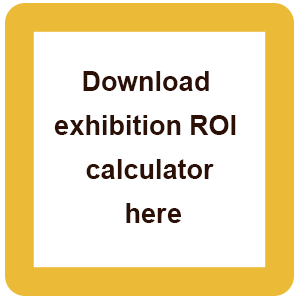How to evaluate the business potential of an exhibition

|

|
Contents |
[edit] Why exhibiting would be part of your marketing plan
Exhibitions can be used for:
- New business generation
- Brand reputation
- Brand awareness
- Insight
Exhibiting offers companies the opportunity to engage large numbers of potential prospects and draw them into their own customer funnel, via the organisers marketing program and the exhibition stand.
Prospects can experience and assess a company’s product first hand and talk face to face with the sales team to build rapport, and trust. Something that is difficult to achieve with other communication channels.
Most exhibitions offer educational programs where exhibitors can participate and build their brand reputation.
Exhibitions can be a great place to see first hand the reaction of potential buyers to your product. This can provide great insight for the creation of communications and product development.
[edit] Choosing an exhibition
Exhibiting requires some investment from the marketing budget and therefore it is important to choose and evaluate the potential of each exhibition so you can prioritise them. You can also then compare the projected outcomes to other marketing tactics.
The primary reason to exhibit is to help the company increase business. Therefore the first thing to look at when choosing a potential exhibition is the audience profile, and how closely it matches the company’s target audience(s).
The exhibition organiser should be able to provide a breakdown of the previous year’s visitors, which should provide reasonable figures to use in an evaluation. For new exhibitions, any figures supplied should be treated with caution.
[edit] Evaluating an exhibition
A common way to evaluate the business potential of an exhibition against other exhibitions and marketing tactics is return on investment (ROI).
To calculate ROI there are two questions that need to be answered:
- How much additional revenue is the exhibition likely to generate?
- How much will it cost to participate in the show?
ROI can be calculated as follows:
(Projected revenue-projected costs)/projected costs*100
[edit] Calculating potential revenue
1. Estimate the number of your target audience likely to visit the show
The show organisers should be able to give you a detailed breakdown of likely numbers and categories of visitors. Most likely based on previous years.
You may want to segment the target audience further by size or your personas.
2. Estimate the percentage of target visitors you are likely to engage via show marketing and stand activity
This will give you the number of prospects you will acquire from the show and bring in to your own customer experience program.
This will be an educated estimate. Insight to inform your estimate could be:
Engagement rates from previous shows
The organiser may have some insight on engagement rates
3. Multiply 2 by your conversion rate of engaged visitors to revenue
Here you should be able to use the conversion rate(s) you are used to achieving once you get a prospect into your customer funnel.
If you have further segmented the audience then you may have different conversion rates for each segment.
4. Multiply 3 by the average revenue per customer
If you are taking a long term view then you should use the average lifetime value of a customer. You may have a single average, or you may have different lifetime customer values by segment.
You now have your projected additional revenue as a result of being an exhibitor/partner at the event.
[edit] Calculating the cost of exhibiting
Add up the following costs:
1. Stand space and utilities
This is the physical stand space you book. It can be space only or a shell scheme. The utilities are other services you may have to hire like additional electrics for machines, wifi, monitors, furniture
2. Stand structure and logistics cost
For the cost of the physical stand you should apportion a part of the total cost of purchasing the stand based on the number of times you are likely to use it.
You should also include the cost of any transportation of the stand to and from the exhibition venue and any set-up and breakdown costs.
3. Marketing costs
These should be any marketing costs pre, during and post show. These could be:
- Invitation campaign
- Media advertising
- Social media
- Content creation
- Collateral
- Premiums
- Uniforms
- Samples/stock
4. Travel and accommodation costs
This will include the travel, accommodation and subsistence costs for personnel who are involved setting up and operating the stand on the days of the show.
[edit] Calculating return on investment
You now have the figures to put in the following formula to calculate your ROI for an event.
ROI = Projected revenue – projected costs)/projected costs*100
If you choose to exhibit at the show then this figure becomes your topline objective against which you can evaluate your success post show.
If you have any questions about any aspect of exhibiting then please email here
[edit] Related articles
--Simon Baxter 16:40, 26 Aug 2020 (BST).
Featured articles and news
One of the most impressive Victorian architects. Book review.
RTPI leader to become new CIOB Chief Executive Officer
Dr Victoria Hills MRTPI, FICE to take over after Caroline Gumble’s departure.
Social and affordable housing, a long term plan for delivery
The “Delivering a Decade of Renewal for Social and Affordable Housing” strategy sets out future path.
A change to adoptive architecture
Effects of global weather warming on architectural detailing, material choice and human interaction.
The proposed publicly owned and backed subsidiary of Homes England, to facilitate new homes.
How big is the problem and what can we do to mitigate the effects?
Overheating guidance and tools for building designers
A number of cool guides to help with the heat.
The UK's Modern Industrial Strategy: A 10 year plan
Previous consultation criticism, current key elements and general support with some persisting reservations.
Building Safety Regulator reforms
New roles, new staff and a new fast track service pave the way for a single construction regulator.
Architectural Technologist CPDs and Communications
CIAT CPD… and how you can do it!
Cooling centres and cool spaces
Managing extreme heat in cities by directing the public to places for heat stress relief and water sources.
Winter gardens: A brief history and warm variations
Extending the season with glass in different forms and terms.
Restoring Great Yarmouth's Winter Gardens
Transforming one of the least sustainable constructions imaginable.
Construction Skills Mission Board launch sector drive
Newly formed government and industry collaboration set strategy for recruiting an additional 100,000 construction workers a year.
New Architects Code comes into effect in September 2025
ARB Architects Code of Conduct and Practice available with ongoing consultation regarding guidance.
Welsh Skills Body (Medr) launches ambitious plan
The new skills body brings together funding and regulation of tertiary education and research for the devolved nation.
Paul Gandy FCIOB announced as next CIOB President
Former Tilbury Douglas CEO takes helm.
























